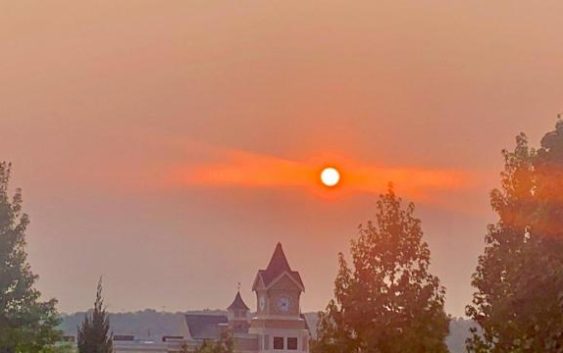- Flooding lingers in Liberty County neighborhoods near Trinity River with more rainfall expected
- North Carolina behind on hurricane preparedness, study shows
- North Carolina way behind on hurricane preparedness, study shows
- New hurricane preparedness report doesn't rank North Carolina well
- New hurricane preparedness report doesn't rank North Carolina well
How western wildfires create red sunsets in North Carolina

Smoke from wildfires across Western Canada, Southern Oregon, Northern California are riding upper level winds across the continent. These hazy conditions bring air quality concerns, but also provide the right conditions for sunsets ranging from brilliant to eerie.Sunlight is white, but it doesn’t stay that way
When viewed from above the atmosphere, such as aboard the International Space Station, the Sun appears white. This is because sunlight is made up of all the colors of the visible part of the electromagnetic spectrum. From longer wavelengths of red and orange through shorter wavelengths of blue, indigo and into violet, they’re all there.
As sunlight passes through the atmosphere, it is scattered by gas molecules and particulates from air pollution, fires or even the occasional volcano. The color of a sunset comes down to the size of what is in the atmosphere, and how much of it is there.
The tiny Nitrogen and Oxygen molecules that make up nearly all of our air are really, really good at scattering blue light’s tiny wavelengths. This is known as Rayleigh scattering, named for British Physicist Lord Rayleigh who described what is happening in an 1871 paper. That scattering of light is what gives the sky its blue color.
Orange skies
The smoke particles in the air these days are much larger than gas molecules and are much better at scattering longer wavelengths of light. This is known as Mie scattering and can create deep orange colors in the sky. When concentrations of big particles like smoke get very high, especially closer to the horizon, Mie scattering overtakes Rayleigh scattering turning blue skies orangy-red.
Red sun
As the Sun gets lower, that light is passing through more atmosphere. 10 times as much 30 minutes before sunset to more than 30 times as much atmosphere at sunset. Nearly all the blue light has been scattered away, even the yellow light prominent in the mid-day is nearly gone.
Those longer red wavelengths pass right through the smoke layer, creating an erie red, even pink glow to the setting Sun.

